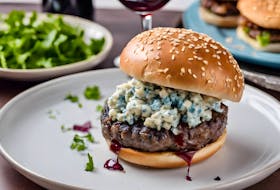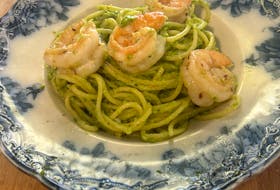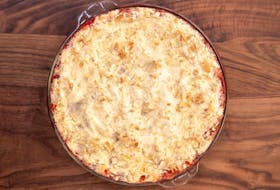To start the year off with something a little different than what we normally eat in landlocked Saskatoon, I cooked up a pot of mussels which had been bathed in chicken broth, a good amount of white wine, and plenty of fresh dill.
With a salad served on the side, and loads of crusty bread for dunking up the delicious broth, dinner was on the table in about 30 minutes. My fella and I hovered over our bowls, greedily picking out the mussels and slurping them out of their shells.
If you had been peering into our window, the word “savage” may have come to mind. Neither of us really spoke until the feast was over, and when the words did come out, they were along the lines of “Holy God, that was good! Is there more? When can we have these again?”
There’s no doubt I will be making mussels again. Not only are they pretty in their sleek blue/black shells, they’re also pretty cool culinary creatures. They’re relatively inexpensive (around $6/pound), easy to cook, and take very little time to prepare once you give them a thorough look over and cleaning.
Mussels are very nutritious, and go well with a rainbow of flavours. As consumers are becoming more aware about the sustainability of the products they put into their grocery carts, it’s important to note that eating mussels is good for the environment.
Most of the mussels we eat these days are cultivated on ropes suspended from floating rafts in clean waters. Mussels, like clams and oysters, are bivalves and members of the invertebrate mollusk family. These bivalves are immobile and plantlike in the way they filter nutrients from the water around them and do not require feeding, like farmed fish and shrimp do.
Mussels plump up naturally on plankton, and develop a meaty, edible muscle that is rich in omega-3s, without the mercury levels found in larger fish. These handy little bivalves literally clean the ocean by straining plankton and other particulates from the water as they eat. They can clean anywhere from 30 to 50 gallons of water per day, improving the habitat for the fish living around them. I like these hard-working little oceanic creatures. Let’s eat more of them in 2020.
Classic Steamed Mussels with White Wine
Buy mussels from a trusted seafood counter. Remember that when you buy them, they are alive. When you get the mussels home from the store, take them off any ice, and keep them in the fridge covered with damp paper towel. Never store them in water. Cook the mussels as soon as possible, within two days of purchase.
2 pounds fresh mussels, cleaned (see below)
1 Tbsp butter
1 large shallot, thinly sliced
2 garlic cloves, minced
1 cup chicken stock
1/2 cup white wine
2 Tbsp whipping cream
1/4 cup chopped fresh dill or parsley
pinch red pepper flakes
salt and pepper to taste
lemon wedges, for serving
slices of warm baguette or toasted French bread, for serving
1. Melt the butter in a large pot over medium heat. Stir in the shallot and garlic, cooking until softened, about five minutes.
2. Add the chicken stock, white wine and cleaned mussels. Give them a good toss. Cover the pot with its lid and cook until all of the mussels have opened, about six minutes.
3. Remove the pot from the heat and stir in the cream, dill, red pepper flakes and season with salt and pepper. Pick out and discard any mussels that have not opened.
4. Divide into two bowls and garnish with fresh lemon wedges. Serve with lots of warm, crusty bread. Makes enough for two people. Recipe can be easily doubled or tripled for a crowd.
How to clean mussels:
Look through the mussels, and toss out any that are cracked, chipped or open. If they don’t close when you give them a little tap, they’re goners. About 20 minutes before making the recipe, place the mussels in a large bowl full of fresh water. As they breathe, they will expel any sand or grit that’s inside the shells.
Most mussels will have a “beard,” which is just the fibres that emerge from the shell of the mussel. You want to remove this by holding a mussel in one hand using a piece of paper towel. Then, pull the beard out and away from the mussel with your other hand. Sometimes it can be a bit tricky to remove, but it will come out. Finally, use a firm brush to remove extra sand and the odd barnacle from the mussels. Rinse the cleaned mussels under plenty of cold water, then place in a clean bowl until you are ready to proceed with the recipe.
Related
Copyright Postmedia Network Inc., 2020








